Digital Branding Strategies
How to Develop a Winning Brand & Communications Strategy: A Step-by-Step Guide
Overview
Developing a winning brand and communications strategy necessitates a structured approach that emphasizes building trust, differentiation, and alignment with business objectives. This article outlines practical steps that are essential for success:
- Defining clear goals
- Understanding the target audience
- Maintaining consistency across channels
Supported by compelling case studies, these strategies demonstrate their effectiveness in enhancing brand visibility and fostering consumer loyalty.
Introduction
In the competitive landscape of modern business, the significance of a well-crafted brand and communications strategy is paramount. It serves as the backbone of marketing efforts, shaping consumer perceptions and fostering lasting connections.
As organizations strive to establish their presence in a crowded marketplace, understanding the elements that contribute to a successful brand strategy becomes essential. Building trust through consistent messaging and differentiating oneself amid a sea of competitors are critical components of this journey.
This article explores the vital elements of a brand strategy, the role of effective communication, and practical steps for creating a robust communications plan, all aimed at enhancing brand visibility and driving consumer engagement. Through insightful case studies and actionable insights, it underscores the transformative power of strategic branding in achieving sustainable business growth.
Understanding the Importance of Brand and Communications Strategy
A robust brand and communications plan is essential for any business seeking to establish a significant market presence. It forms the foundation of your branding and communications efforts, influencing audience interactions and shaping perceptions of your identity. A clearly defined strategy is critical in several key areas:
- Building Trust: Consistent messaging is paramount for fostering trust among consumers. When companies deliver messages uniformly, they increase the likelihood of customer engagement and loyalty. Indeed, data indicates that 73% of shoppers make purchasing decisions influenced by a product’s visual appeal, underscoring the importance of cohesive branding in building trust.
- Differentiation: In today’s saturated market, a distinctive identity is vital for standing out from competitors. An original approach not only captures attention but also aids in customer retention. This necessity is further supported by the fact that 57% of clients believe a significant portion of content produced by businesses lacks authenticity, highlighting the need for genuine storytelling in branding to meet customer expectations.
- Alignment: A clear strategy ensures that all marketing efforts are synchronized with your business objectives, enhancing overall effectiveness. This alignment is crucial for executing successful brand and communications campaigns that resonate with your target audience.
Understanding these components is the first step toward crafting an effective strategy that not only connects with your audience but also promotes sustainable business growth. Notable case studies, such as the comprehensive campaign for Quaker Oats, illustrate how innovative branding strategies can enhance visibility and foster customer loyalty. This campaign resulted in increased awareness of the company and engagement from clients, showcasing the efficacy of WonderEight’s approach.
By focusing on creating emotional connections through storytelling and engagement, businesses can significantly boost customer retention and trust. As highlighted by Sprout Social, 55% of consumers expect companies to interact with them on social media, further emphasizing the importance of engagement in cultivating loyalty. Furthermore, WonderEight offers tailored branding solutions that cater to diverse client needs, ensuring that each strategy is uniquely crafted to achieve optimal results.
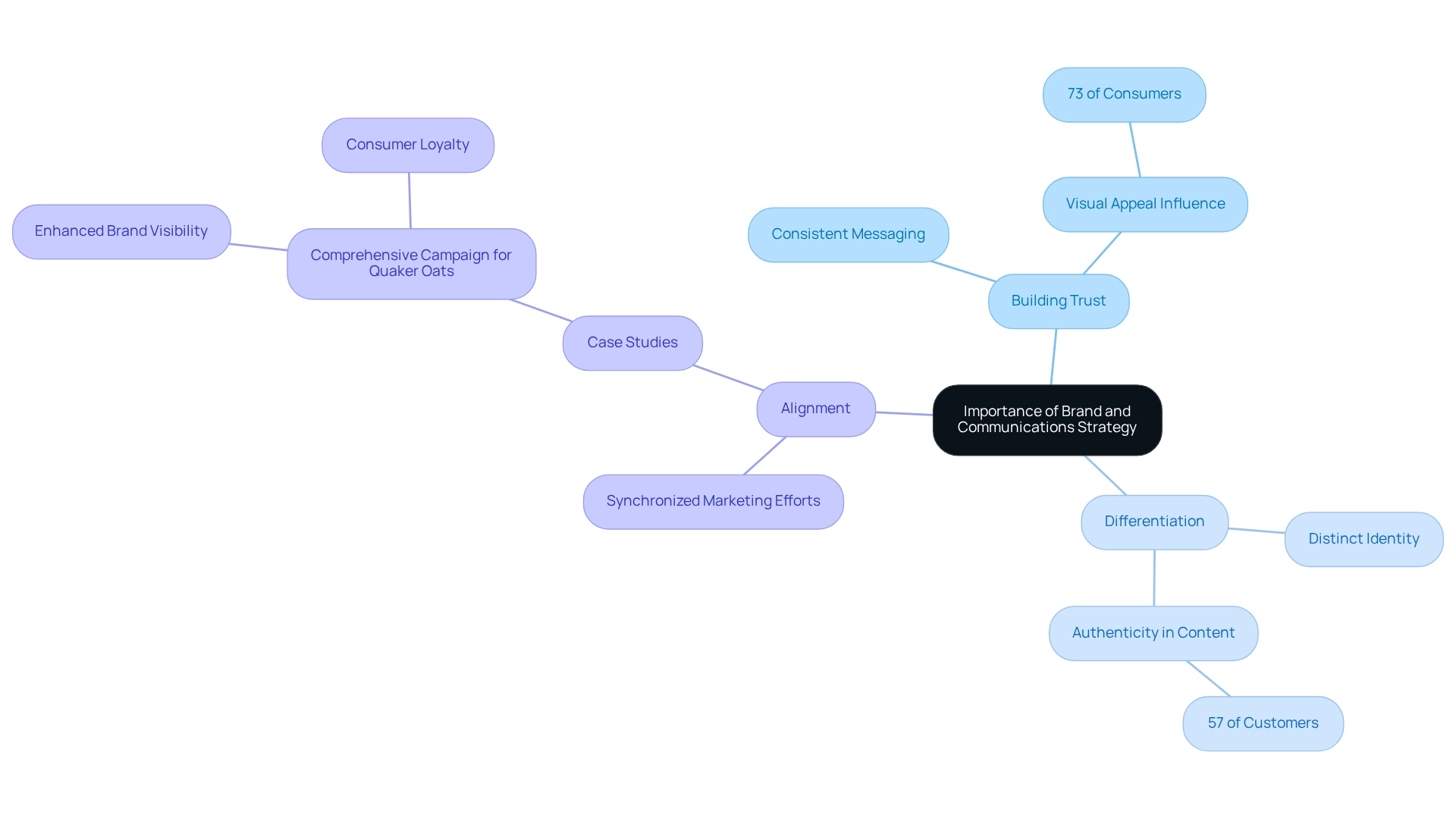
Key Components of a Successful Brand Strategy
A successful branding approach is constructed on several key elements that collaborate to establish a captivating identity:
-
Purpose: Expressing why your entity exists beyond mere profit is crucial. A clear organizational purpose resonates deeply with your target audience, fostering loyalty and trust. In fact, 50% of marketers acknowledge customer loyalty as a primary goal in their content marketing strategies, emphasizing the significance of a purpose-driven approach. The extensive campaigns created by WonderEight for Mirinda and Quaker Oats illustrate how a strong purpose can enhance customer connection and visibility. Understanding your audience’s needs, preferences, and behaviors allows for more effective communication. Studies reveal that only 29% of low-income consumers have confidence in their labels, in contrast to 38% of high-income shoppers. This disparity underscores the importance of customizing your approach to your audience’s demographics and values, as comprehending these trust levels can guide your positioning strategy.
-
Positioning: Determine how you want your identity to be perceived in the marketplace relative to competitors. This involves outlining your unique selling proposition (USP) and ensuring it is conveyed clearly to distinguish your identity.
-
Messaging: Create a consistent message that encapsulates your values and benefits. This messaging should be reflected across all marketing channels to fortify your identity. For instance, posts featuring images generate 650% greater engagement than text-only posts, demonstrating the effectiveness of visual storytelling in company communication and highlighting the significance of a unified visual identity.
-
Visual Identity: Develop a cohesive visual identity that encompasses logos, color schemes, and typography, aligning with your entity’s personality and appealing to your audience. A strong visual identity not only boosts recognition but also deepens emotional ties with consumers.
These elements together form a solid foundation for your marketing strategy, ensuring that all promotional efforts are coordinated and impactful. Successful case studies, such as the comprehensive campaigns created by WonderEight for Mirinda and Quaker Oats, illustrate how these elements can enhance visibility and consumer connection, ultimately driving measurable outcomes.
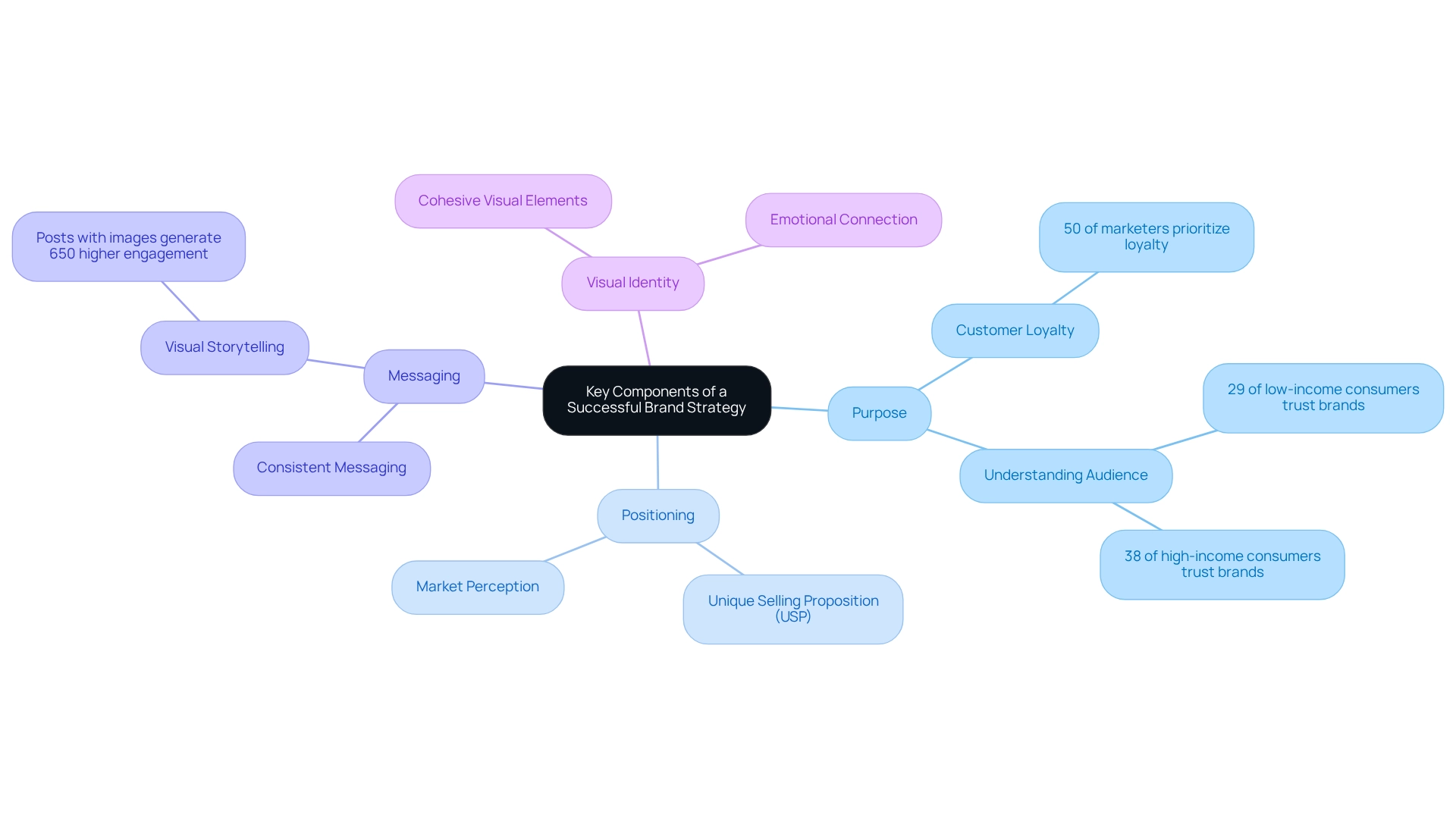
The Role of Effective Communication in Brand Identity
Effective brand and communications are essential for establishing and sustaining a robust identity. They articulate how your brand and communications convey your company’s values, mission, and personality to its audience. The following key aspects are crucial:
-
Clarity: Messages must be straightforward and easily comprehensible. Avoiding jargon ensures that your audience quickly grasps your company’s core message. In fact, statistics reveal that 13% of companies fail to enforce their guidelines, resulting in confusion and diluted messaging. This underscores the importance of WonderEight’s audits and strategy development services in helping businesses maintain clarity in their brand and communications.
-
Consistency: A uniform tone and style across all communication channels are vital. This consistency not only strengthens product recognition but also fosters trust among buyers. Brands and communications that embody clear and consistent messaging are better positioned to meet high expectations from buyers in 2024 and beyond. As companies are anticipated to represent unique personalities and values, WonderEight’s expertise in developing customized brand and communications strategies becomes increasingly relevant.
-
Engagement: Promoting two-way communication nurtures a sense of community around your identity. Actively seeking feedback and interaction can significantly enhance consumer loyalty and trust. Notably, over 90% of individuals would consider a job offer from a company with a strong corporate reputation, highlighting the importance of brand and communications in shaping public perception. This aligns with WonderEight’s brand and communications strategies that enhance reputation and attract top talent.
-
Storytelling: Employing storytelling techniques can forge emotional connections with your audience. Sharing narratives that reflect your values and mission makes your identity more relatable. For instance, Nike’s storytelling approach emphasizes inspirational narratives over mere product promotion, resulting in memorable campaigns that resonate deeply with consumers. Similarly, WonderEight’s successful initiatives, such as the identity enhancement for Castania, illustrate how effective communication tactics can create significant experiences. By prioritizing these aspects, companies can effectively convey their brand and communications, fostering trust and loyalty among their followers. As emphasized by industry specialists, prioritizing authenticity, storytelling with a human touch, and immersive technology can assist companies in navigating the complexities of the digital age while establishing genuine connections with their audience.
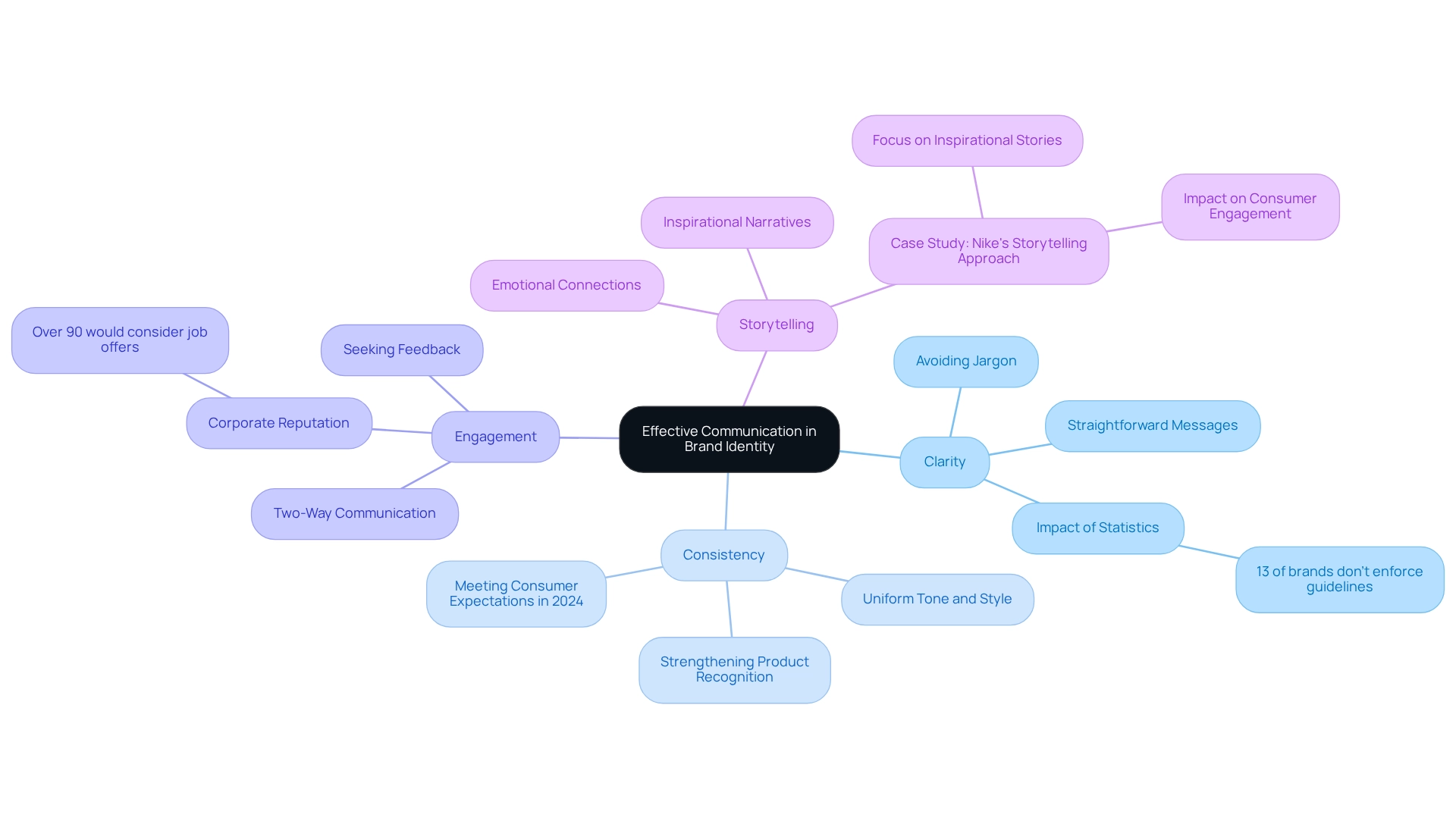
Practical Steps to Create a Brand Communications Plan
Creating a brand communications plan involves several essential steps that can significantly enhance your brand’s effectiveness in reaching and engaging your audience:
-
Define Your Objectives: Clearly outline your goals for the communications plan. Objectives may include increasing product awareness, driving sales, or enhancing customer engagement. Notably, 65% of consumers perceive favorable interactions with companies as more impactful than conventional advertising, underscoring the importance of clearly defined goals. As Monique Solomons asserts, “Enhancing your branding requires comprehending your target market, distinctly articulating your unique selling proposition, consistently conveying your message across all platforms…” This statement emphasizes the necessity for clarity in your objectives.
-
Identify Your Target Group: Understanding your intended demographic is essential. Segment them based on demographics, interests, and behaviors to tailor your messaging effectively. Engaging directly with consumers is crucial, as 55% prefer companies to interact with them on social media. This statistic highlights the significance of target identification, a core aspect of WonderEight’s services.
-
Craft Your Key Messages: Develop essential messages that align with your purpose and resonate with your audience. Consistency is paramount; ensure these messages are uniform across all platforms to reinforce your brand identity.
-
Choose Your Channels: Identify the most effective communication channels for connecting with your target group. Options may include social media, email marketing, or traditional advertising. The selection of channels should reflect where your audience is most active and engaged.
-
Set a Timeline: Establish a detailed timeline for your communications plan, specifying when and how often you will engage with your audience. This organized approach aids in maintaining consistency and keeps your identity top-of-mind.
-
Evaluate and Adjust: Regularly assess the effectiveness of your communications plan. Gather feedback and analyze engagement metrics to make necessary adjustments. This iterative process ensures that your strategy remains relevant and effective.
By following these steps, you can create a comprehensive plan for brand communications that effectively conveys your message and fosters meaningful engagement with your audience. Successful examples, such as the comprehensive campaign for Quaker Oats, illustrate how strategic planning can lead to a stronger market presence and improved consumer perception, showcasing WonderEight’s expertise in creating impactful communications. Furthermore, WonderEight has effectively executed comparable approaches for various clients, resulting in significant enhancements in engagement and market presence.
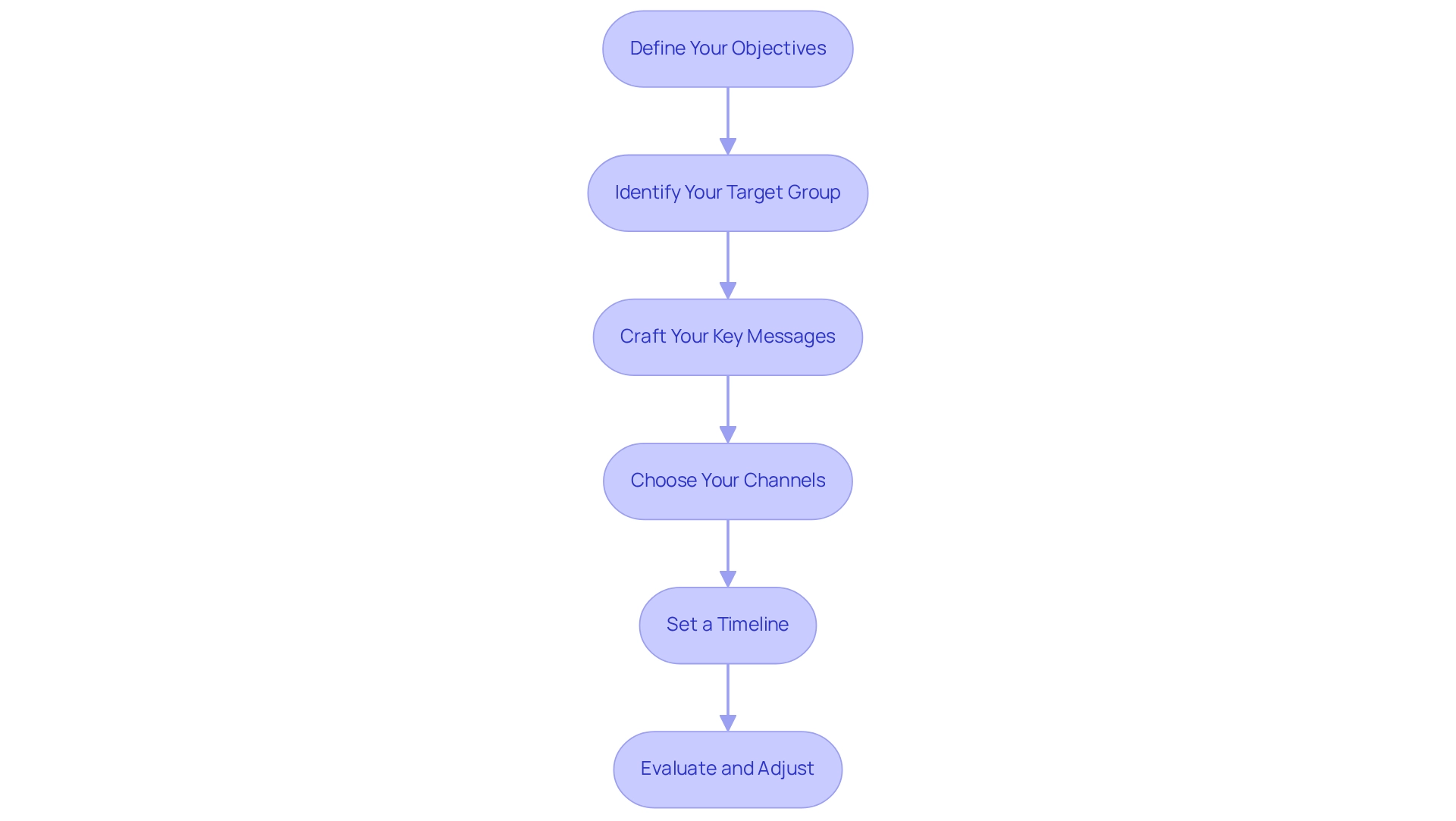
Overcoming Challenges in Brand Strategy Execution
Implementing a marketing plan presents various challenges in brand and communications that companies must manage with efficiency. Addressing these obstacles with strategic solutions is essential for success.
- Lack of Clarity: A major barrier to executing a successful marketing strategy is the lack of clarity among team members regarding their roles and the overall strategy. It is crucial to ensure that every individual understands the organization’s objectives and their specific contributions to brand and communications. Regular meetings and comprehensive documentation foster alignment and keep the team informed. WonderEight’s digital audits can clarify objectives and enhance communication among teams, employing structured frameworks to improve comprehension.
- Inconsistent Messaging: Inconsistent messaging can dilute a company’s identity and confuse consumers. Developing a comprehensive guide that outlines messaging, tone, and visual identity is vital. This guide should serve as a reference for all team members, ensuring that brand and communications remain consistent across all channels and platforms. WonderEight’s social media planning services can help sustain a unified voice across different platforms, utilizing focused content approaches to strengthen identity.
- Resource Constraints: Organizations often face budget and staffing limitations, which can hinder the implementation of identity initiatives. In such cases, prioritizing key initiatives that align closely with the company vision is essential. Concentrating on high-impact activities in brand and communications can maximize results, even with limited resources. WonderEight’s integrated marketing solutions, encompassing e-commerce and CRM approaches, can assist organizations in optimizing their resources effectively, ensuring that every initiative aligns with strategic objectives for maximum impact.
- Resistance to Change: Implementing a new branding approach can meet resistance from stakeholders accustomed to existing practices. Clearly conveying the advantages of the new approach is important to alleviate concerns. Involving stakeholders in the brand and communications process fosters buy-in and reduces apprehension about change. WonderEight’s events and activations can serve as platforms to engage stakeholders and illustrate the value of new initiatives, utilizing interactive experiences to showcase the benefits of the new approach.
- Measuring Success: Establishing clear metrics for success from the outset is crucial for assessing the effectiveness of the brand and communications identity approach. Consistently evaluating performance against these metrics enables organizations to make informed adjustments to their plans as necessary. WonderEight’s digital approach services provide essential tools for monitoring performance and ensuring alignment with brand objectives, utilizing analytics to evaluate success and guide future strategies.
Statistics indicate that organizations effectively implementing new growth plans can increase profitability by 77%. However, nearly a quarter of organizations review their plans for execution only once a year, which can result in stagnation. Furthermore, 58% of organizations believe their performance management systems are inadequate for tracking performance.
By anticipating these challenges and preparing to address them with comprehensive solutions from WonderEight, brands can significantly enhance their brand and communications strategies, ultimately leading to improved clarity and consistency in their branding efforts. As emphasized in a recent case study, addressing ongoing implementation challenges is vital for organizations to unlock their growth potential. According to Gartner, organizations that effectively harness the capacity to implement new growth plans enhance their profitability by 77%.

Maintaining Consistency Across Multiple Channels
Maintaining consistency in your brand and communications across various channels is essential for strengthening your identity. Here are key strategies to achieve this:
- Develop a Style Guide: Create a comprehensive guide that outlines your visual identity, messaging, and tone. This guide should be easily accessible to all team members and partners, serving as a foundational resource for brand and communications related to the organization.
- Regular Training: Conduct training sessions for employees and partners to ensure everyone understands the guidelines and how to apply them effectively in their communications. Consistent training promotes a culture of awareness and compliance in brand and communications.
- Monitor Presence: Regularly review your representation across all channels. Utilize monitoring tools to track how your name is perceived and make necessary adjustments to maintain alignment with your established guidelines.
- Feedback Mechanisms: Establish channels for gathering feedback from customers and employees regarding perception. This feedback is invaluable for refining your approach and ensuring that your identity remains consistent and relevant.
- Adaptation with Consistency: While consistency is essential, be prepared to adapt your messaging for different platforms. Ensure that the central message remains intact while adjusting the presentation to suit the distinct traits of each medium.
Executing these approaches not only boosts customer loyalty—demonstrated by the statistic that 59% of shoppers would wait for items from their preferred brands instead of seeking alternatives—but also guarantees a unified brand and communications strategy that connects with your audience across all interactions. The significance of a style guide in brand and communications is highlighted by its function in cultivating deeper loyalty over time, as a consistent identity is viewed as more dependable and credible. Moreover, as Kerry Hounslea observed, the growing influence of AI in marketing methods can help in preserving consistency and enhancing brand and communications techniques.
Furthermore, the case study of Gap’s 2010 logo redesign illustrates the risks associated with inconsistency in brand and communications, highlighting the need for careful alignment with customer expectations. Lastly, a UX redesign can significantly enhance online sales for e-commerce sites, underscoring the importance of a cohesive brand and communications identity across digital platforms.
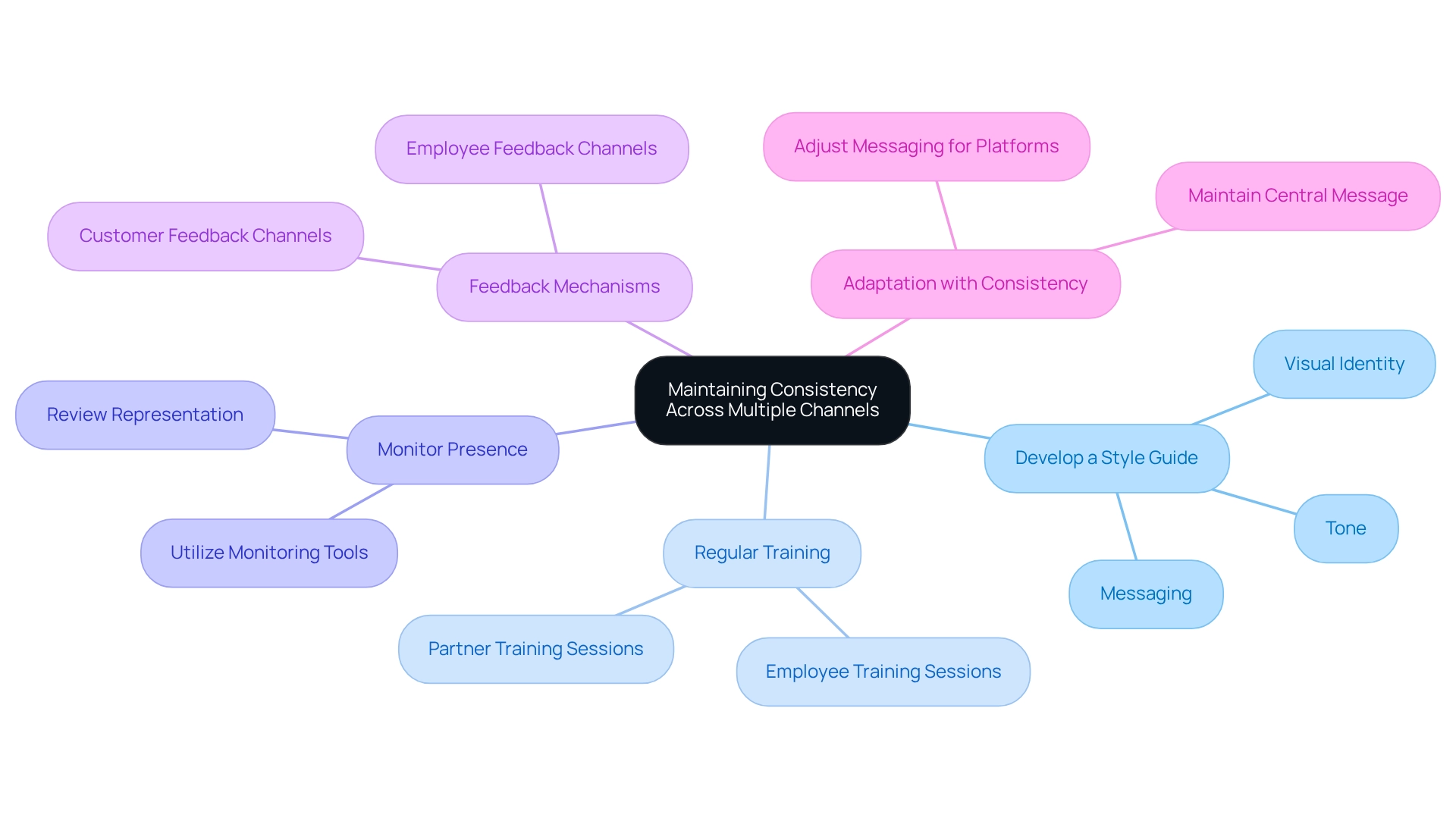
Measuring the Effectiveness of Your Brand Strategy
Assessing the effectiveness of your marketing approach is crucial for comprehending its influence and making informed modifications. To evaluate your strategy effectively, consider the following key methods:
-
Brand Awareness Surveys: Conducting surveys is essential to gauge how well your target audience recognizes your brand and understands its values. In 2025, statistics reveal that a significant portion of brands—15%—lack brand guidelines, underscoring the necessity for structured approaches to brand and communications awareness and measurement.
-
Engagement Metrics: Analyzing engagement metrics across social media platforms, such as likes, shares, and comments, is vital for assessing how well your content resonates with your audience. Brands that optimize digital content and incorporate interactive elements can significantly boost visibility and deepen emotional connections with audiences. This is illustrated in the case study ‘Capitalizing on Digital Engagement,’ which discusses best practices for enhancing audience interaction.
-
Sales Data: Observing sales information before and after executing your marketing approach is essential for assessing its effect on revenue. Notably, 71% of consumers in the UK demonstrate heightened confidence in companies through their buying behavior, highlighting the strong relationship between an effective marketing approach and enhanced sales performance.
-
Net Promoter Score (NPS): Utilizing NPS to measure customer loyalty and satisfaction provides insights into how your company is perceived by customers. This metric is instrumental in understanding customer sentiment and can guide strategic adjustments.
-
Website Analytics: Employing tools like Google Analytics to track website traffic, user behavior, and conversion rates is critical for understanding the effectiveness of your online presence. These insights can inform decisions that enhance user experience and drive engagement.
By consistently evaluating these elements, companies can obtain important insights into their brand and communications performance, enabling them to make necessary modifications to improve their strategies. Comprehending product recognition through key statistics, such as the 15% of brands lacking guidelines and the 71% consumer trust figure, is essential for marketers to create engaging narratives that promote market success.

Case Studies: Successful Brand and Communications Strategies
Examining successful brand and communications strategies unveils invaluable insights that can steer future endeavors. Notable case studies illustrate this:
-
Nike: The ‘Just Do It’ campaign exemplifies Nike’s prowess in conveying empowerment and motivation. The campaign’s consistent messaging across diverse platforms has not only solidified Nike’s identity as a leader in athletic apparel but also contributed to a remarkable 18% increase in engagement on digital platforms for companies that adapt to market trends, as highlighted by Sarah Lee. This success underscores the importance of a cohesive message that resonates with consumers.
-
Coca-Cola: The ‘Share a Coke’ campaign revolutionized customer engagement through personalization. By replacing its iconic logo with popular names, Coca-Cola significantly boosted consumer engagement and loyalty. This strategy underscores the power of personalization in branding, illustrating how tailored experiences can cultivate deeper connections with audiences.
-
Apple: Apple’s branding strategy is anchored in simplicity and innovation. The company’s consistent messaging and sleek design across its products and marketing materials have fostered a strong, recognizable identity. This approach not only resonates with customers but also fortifies Apple’s status as a market leader, demonstrating the efficacy of maintaining a clear and cohesive vision. Additionally, this initiative has enhanced its image and created a robust emotional bond with its audience, as evidenced by Dove’s efforts in addressing societal issues and promoting inclusivity.
-
Castania: The identity enhancement for Castania exemplifies how strategic rebranding can amplify market presence and consumer loyalty. By focusing on a unified message and visual identity, Castania has successfully connected with its target audience.
-
Motorola: The digital campaign for Motorola showcases the effectiveness of integrating innovative digital strategies with traditional branding efforts. This approach has yielded measurable results, elevating Motorola’s visibility and engagement in a competitive market.
These case studies illustrate how effective brand and communications techniques can lead to significant business success. They serve as inspiration for brands aiming to refine their strategies, emphasizing the importance of consistency, personalization, and emotional connection in crafting a lasting brand identity. Furthermore, it is noteworthy that posts featuring images generate 650% higher engagement than text-only posts, reinforcing the discussion on effective communication strategies in branding.
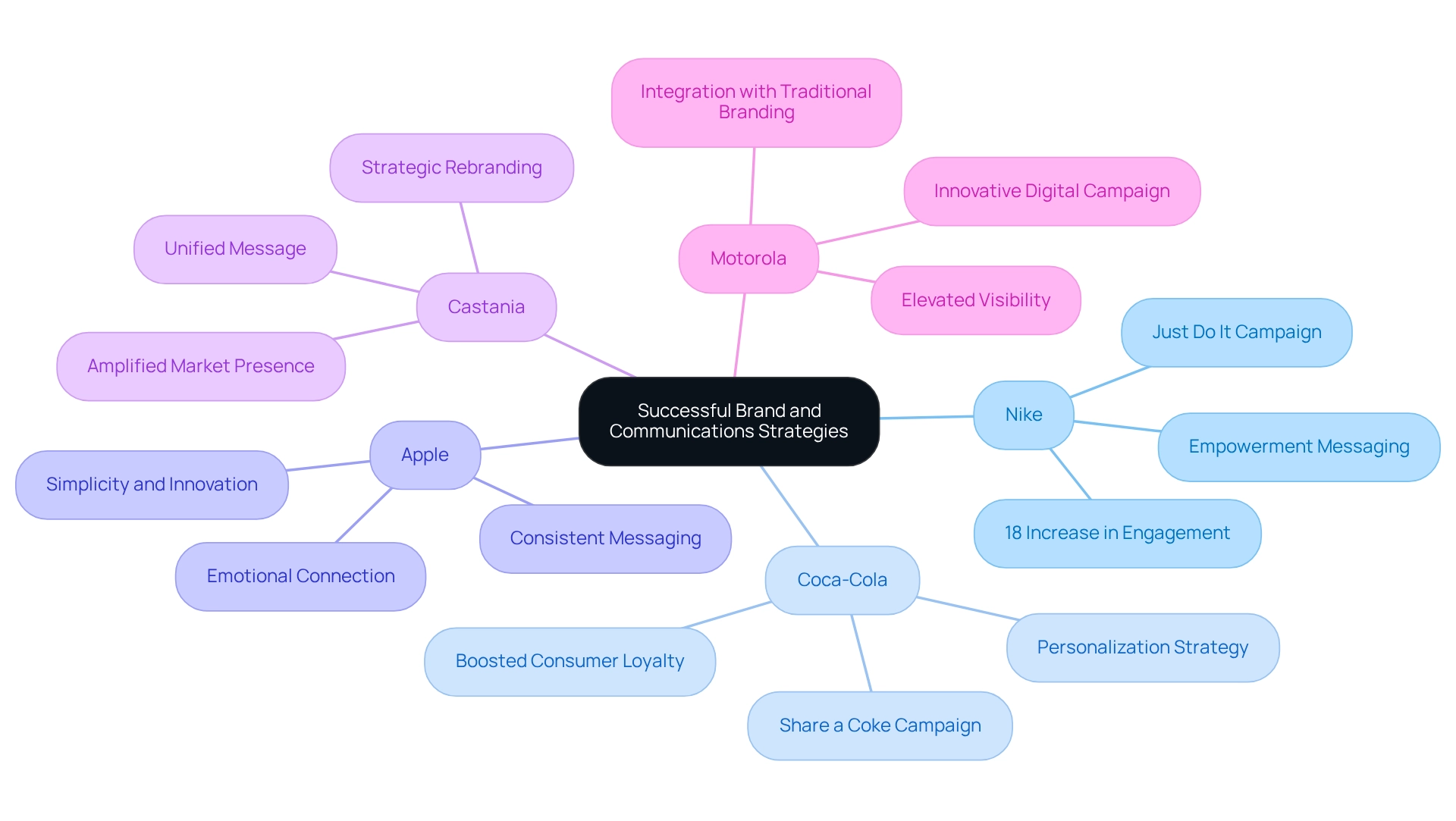
Conclusion
In today’s competitive business landscape, a well-defined brand and communications strategy is not just beneficial—it’s essential for success. This article underscores the critical elements that contribute to a robust brand strategy:
- Building trust through consistent messaging
- Differentiating from competitors
- Aligning marketing efforts with business objectives
Insightful case studies reveal that effective branding enhances visibility and fosters deeper connections with consumers, ultimately driving engagement and loyalty.
The core components of a successful brand strategy—purpose, target audience, positioning, messaging, and visual identity—work in unison to create a compelling brand identity. Effective communication is pivotal in maintaining this identity, emphasizing clarity, consistency, engagement, and storytelling. Practical steps for creating a brand communications plan further reinforce the importance of strategic planning, ensuring that brands can effectively reach and engage their audiences.
Navigating challenges in brand strategy execution is equally important. Solutions such as maintaining clarity, ensuring consistent messaging, and measuring success are vital to overcoming obstacles. The ability to maintain consistency across multiple channels while adapting to audience needs proves crucial in building brand loyalty and trust.
Measuring the effectiveness of brand strategies through various metrics allows organizations to refine their approaches and enhance their impact. By learning from successful case studies, brands can draw inspiration and insights that guide their own strategies, underscoring the transformative power of strategic branding in achieving sustainable business growth. Embracing these principles positions brands for success and fosters lasting relationships with consumers, paving the way for continued engagement and loyalty in an ever-evolving marketplace.
Frequently Asked Questions
Why is a robust brand and communications plan important for a business?
A robust brand and communications plan is essential for establishing a significant market presence. It forms the foundation of branding efforts, influencing audience interactions and shaping perceptions of the business identity.
How does consistent messaging build trust with consumers?
Consistent messaging is crucial for fostering trust among consumers. Uniform messaging increases the likelihood of customer engagement and loyalty, with data indicating that 73% of shoppers make purchasing decisions influenced by a product’s visual appeal.
What role does differentiation play in branding?
Differentiation is vital in a saturated market, as a distinctive identity helps businesses stand out from competitors. An original approach captures attention and aids in customer retention, with 57% of clients believing much business content lacks authenticity.
How does alignment in branding strategies enhance effectiveness?
A clear branding strategy ensures that all marketing efforts are synchronized with business objectives, enhancing overall effectiveness. This alignment is crucial for executing successful brand and communications campaigns that resonate with the target audience.
What is the significance of purpose in branding?
A clear organizational purpose that goes beyond profit fosters loyalty and trust among consumers. About 50% of marketers prioritize customer loyalty in their content marketing strategies, highlighting the importance of a purpose-driven approach.
How can businesses effectively position their brand in the marketplace?
Effective positioning involves determining how a brand should be perceived relative to competitors by outlining a unique selling proposition (USP) and ensuring it is clearly communicated.
What is the importance of consistent messaging in branding?
Consistent messaging encapsulates a brand’s values and benefits and should be reflected across all marketing channels to fortify identity. Visual storytelling, such as posts with images, generates significantly greater engagement compared to text-only posts.
How does visual identity contribute to branding?
A cohesive visual identity, including logos, color schemes, and typography, aligns with a brand’s personality and appeals to its audience. A strong visual identity boosts recognition and deepens emotional ties with consumers.
Can you provide examples of successful branding strategies?
Notable case studies, such as the comprehensive campaigns for Quaker Oats and Mirinda by WonderEight, illustrate how effective branding strategies enhance visibility and foster customer loyalty, ultimately driving measurable outcomes.



